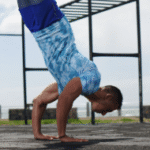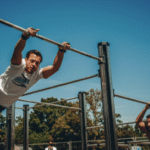Measuring Success How Private Calisthenics Coaches Track Progress
When you invest in private calisthenics coaching in a results-driven city like Houston, you’re investing in a tangible transformation. But how is that transformation actually measured? Success in calisthenics is far more nuanced than simply losing weight or lifting more. It’s a holistic journey of building strength, mastering skills, and enhancing your overall quality of life.
A professional coach doesn’t rely on guesswork. They use a comprehensive, multi-layered system to track your progress, combining hard data with qualitative milestones. This guide details the key methods they use to ensure you are consistently moving forward.
Pillar 1: Quantitative Performance Metrics (The Hard Data)
This is the objective, undeniable proof of your progress. Your coach will meticulously log these numbers in a training journal or app to track your development over time.
Metric
How It’s Tracked
Why It’s a Key Indicator of Success
Max Reps & Sets
A training log is used to record the number of repetitions and sets you can complete for a given exercise with perfect form.
This is the most direct measure of muscular endurance and strength. Going from 3 sets of 5 push-ups to 3 sets of 10 is a clear, motivating victory.
Max Hold Times (Isometrics)
A stopwatch is used to time how long you can hold static positions like a plank, L-sit, or a wall-assisted handstand.
This is crucial for calisthenics. Increased hold times indicate a significant increase in stabilizer strength and muscular control, which are foundational for advanced skills.
Time Under Tension (TUT)
The coach will prescribe and track the tempo of your reps (e.g., lowering for 3 seconds, pausing for 1, pushing up for 1).
As you get stronger, you can handle a slower, more controlled tempo. This demonstrates a massive increase in control and strength through the entire range of motion.
Reduced Assistance
This is tracked by using progressively thinner resistance bands or requiring less physical support from the coach.
This is a clear, measurable step towards independence and skill mastery. Moving from a heavy band-assisted pull-up to a light one is a huge milestone.
Pillar 2: Qualitative Skill Acquisition (The Technical Milestones)
This is where the expertise of a coach truly shines. Calisthenics is a skill-based discipline, and your progress is often measured by the quality of your movement, not just the quantity.
The Tool: Video Analysis
Your coach will regularly record videos of you performing key movements. This is a non-negotiable tool for a serious coach. By reviewing the footage with you, they can provide objective, visual feedback.
What’s Measured:
Form and Technique: The coach will compare your form from week 1 to week 8. Success is seeing a push-up transform from having sagging hips and flared elbows to a perfect, rigid plank-like movement. They look for specific technical improvements, such as proper scapular retraction in a row or maintaining a hollow body position in a handstand.
Progression Mastery: Success is defined by your ability to master one progression before moving to the next. For example, in the journey to a muscle-up, successfully performing clean, explosive chest-to-bar pull-ups is a critical milestone that a coach will track and celebrate with you.
Pillar 3: Biometric and Aesthetic Changes (The Physical Transformation)
While performance is key, visual changes are also a powerful motivator and a clear sign of success.
Progress Photos: Taken from the front, side, and back under consistent lighting conditions every 4-6 weeks, progress photos provide undeniable visual evidence of your transformation. They often reveal changes in posture and muscle definition that you might not notice in the mirror day-to-day.
Body Measurements: Using a simple tape measure, a coach will track the circumference of key areas like the waist, hips, chest, and arms. This is often a much better indicator of progress than the scale, as you may be losing fat while gaining muscle, causing your weight to remain stable but your measurements to improve.
Body Composition (Advanced): For clients with specific goals, a coach may recommend using advanced tools available in Houston, like an InBody or DEXA scan, to get precise data on changes in muscle mass and body fat percentage.
[Image collage showing a “before” and “after” photo of a client, highlighting improved posture and muscle definition.]
Pillar 4: Subjective and Functional Feedback (The Real-World Impact)
Perhaps the most important measure of success is how your training impacts your daily life. A great coach will regularly check in with you on these subjective markers.
Reduced Pain and Discomfort: Are your chronic lower back pain or tight shoulders improving? Success is being able to move through your day pain-free.
Increased Energy Levels: Do you feel more energetic and less fatigued during your workday?
Improved Daily Function: Are everyday tasks, like carrying groceries, playing with your kids at Discovery Green, or lifting a suitcase into an overhead bin, noticeably easier?
Boosted Confidence and Self-Efficacy: This is the ultimate goal. Success is the feeling of empowerment and confidence that comes from mastering your own body, achieving things you once thought impossible, and feeling strong and capable in your own skin.
Conclusion:
Measuring success in private calisthenics is a holistic, 360-degree process. A skilled coach in Houston acts as your personal data analyst, technical expert, and motivational partner, using a combination of objective numbers, visual evidence, and subjective feedback to paint a complete picture of your progress. This comprehensive approach ensures that you not only see results, but that you also understand and appreciate every step of your transformative journey.

Measuring Success How Private Calisthenics Coaches Track Progress
Route
Calisthenics Gym Houston Functional Bodyweight Training
Secondary phone: (346) 483-3195
Email: info@calisthenicsclubhouston.com
URL: https://calisthenicsclubhouston.com/
Monday 6:00 AM - 7:00 PM Tuesday 6:00 AM - 7:00 PM Wednesday 6:00 AM - 7:00 PM Thursday 6:00 AM - 7:00 PM Friday 12:00 PM - 6:30 PM Saturday 9:45 AM - 12:00 PM Sunday 3:00 PM - 5:00 PM





